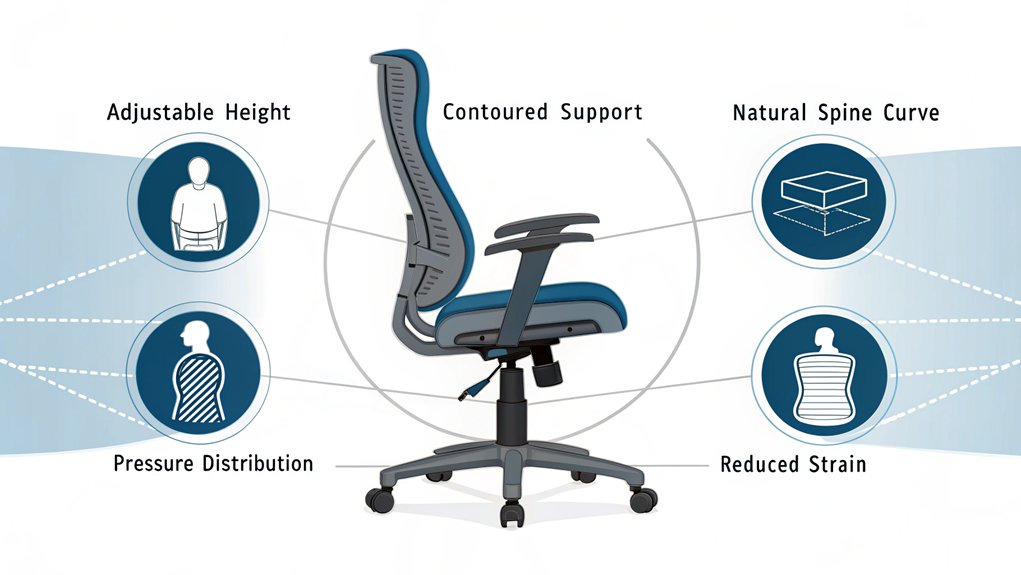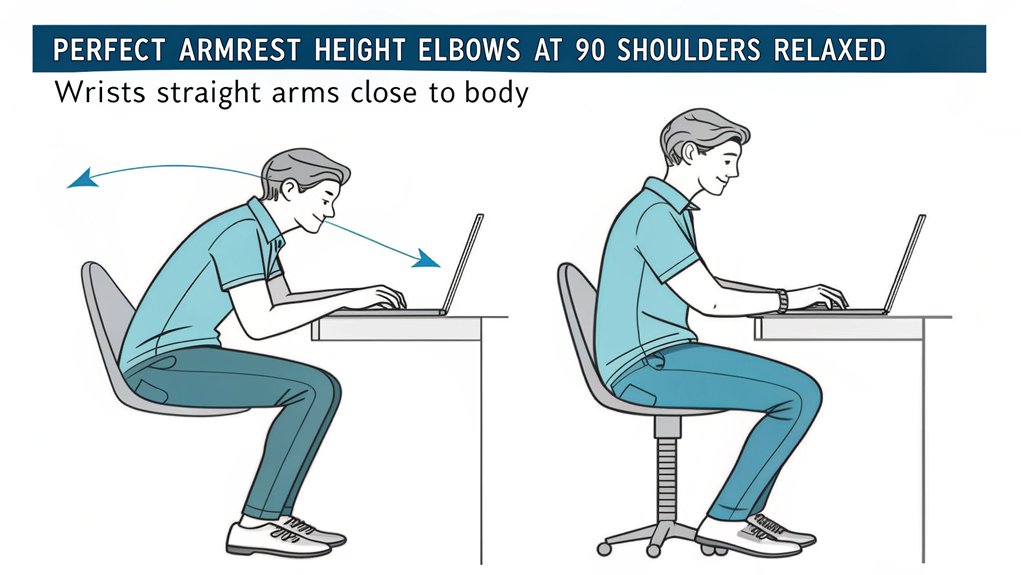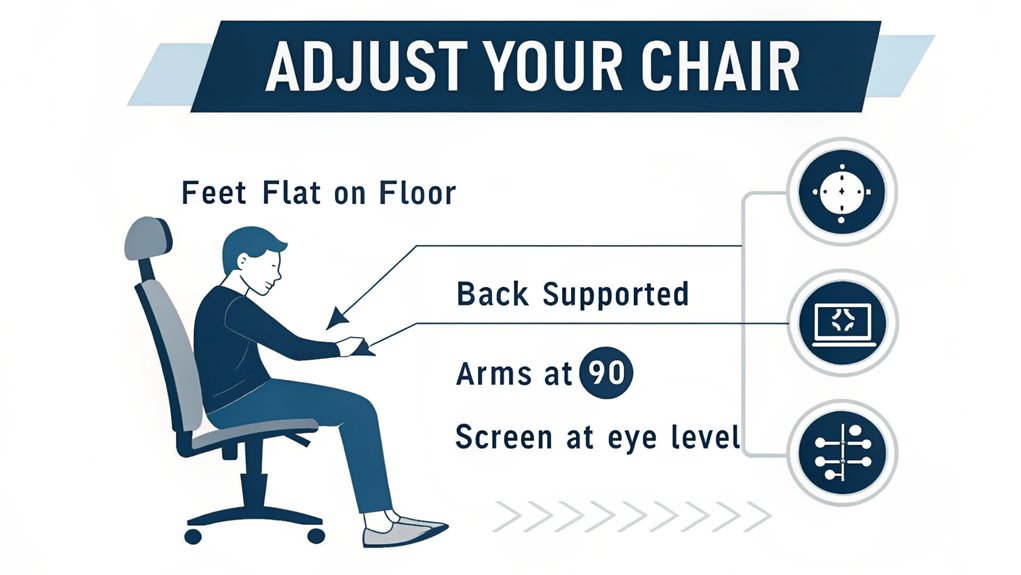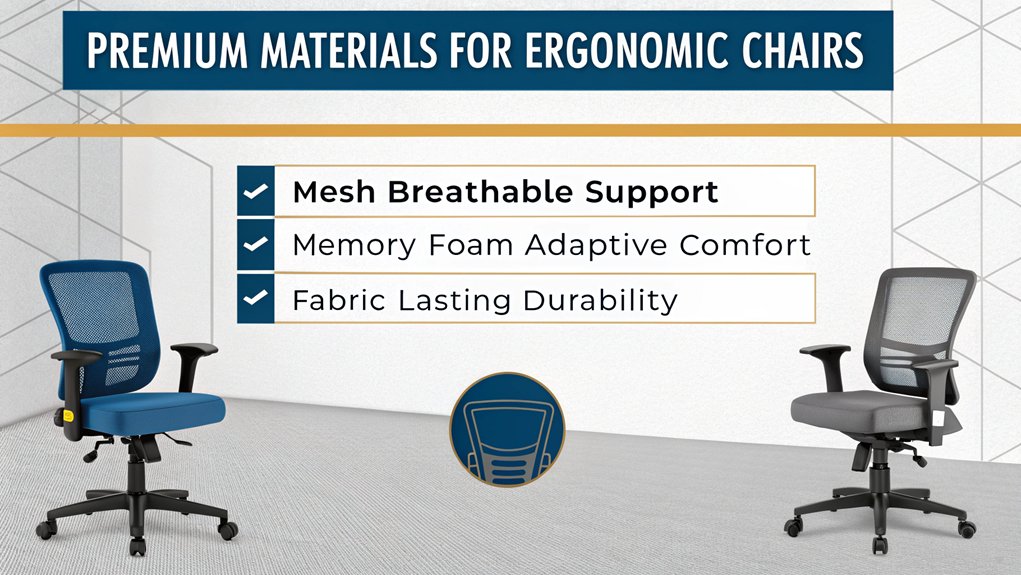You’ll notice the difference in your workday when you’ve got your ergonomic chair configured correctly. Poor posture leads to muscle strain, decreased focus, and reduced output – but these issues don’t have to plague your productivity. With proper adjustments and positioning techniques, you can transform your office chair into a tool that supports both comfort and efficiency. Let’s explore five proven methods to optimize your home office setup to improve productivity with ergonomic chairs!
Key Takeaways
- Adjust seat height and depth to maintain feet flat on the floor and thighs parallel, ensuring proper blood circulation and comfort.
- Position armrests at the right height for relaxed elbows at 90 degrees, reducing shoulder and neck strain.
- Customize lumbar support settings to match your spine’s natural curve and prevent lower back pain.
- Use the synchro-tilt mechanism for natural movement between tasks while maintaining proper posture support.
- Choose chairs with breathable materials and high-density cushioning to stay comfortable during extended work sessions.
Choose the Right Seat Height and Depth
When selecting an ergonomic chair, proper seat height and depth are essential for maintaining ideal posture and preventing musculoskeletal strain.
You’ll need to verify your feet rest flat on the floor while keeping your thighs parallel to the ground. The ideal seat depth should allow 2-4 inches of clearance between the back of your knees and the seat’s edge.
Consider the seat width and cushion firmness that best suit your body type and work requirements.
Your chair’s width should provide adequate hip support while allowing unrestricted movement. The cushion should offer balanced firmness – not too soft to cause sinking, nor too rigid to create pressure points.
Adjust these parameters throughout your workday to maintain optimal ergonomic positioning and promote healthy circulation in your lower extremities.
Support Your Lower Back With Proper Lumbar Features

Three critical lumbar support features determine how well your office chair protects your lower back. Your chair should have height-adjustable lumbar support that you can position precisely in the curve of your spine.
The support’s depth should also adjust, allowing you to customize the pressure against your lower back. Finally, make sure the lumbar mechanism can flex as you move to maintain constant contact.
You’ll want to test these features during your workday to prevent back pain. Adjust the height so the support cradles the natural curve of your spine, typically between your waist and mid-back.
Set the depth to provide firm yet comfortable pressure. If you’re experiencing discomfort, readjust the position until you find your ideal setting.
Advanced chairs now offer dynamic lumbar support that automatically adapts to your movements.
Perfect Your Armrest Position for Better Typing

Proper armrest positioning plays an essential role in preventing shoulder and wrist strain while typing.
You’ll need to adjust your armrest height so your elbows maintain a relaxed 90-degree angle while your forearms remain parallel to the floor. This creates an ideal typing angle that reduces tension in your shoulders and neck.
Make sure the armrests don’t interfere with your chair’s proximity to the desk. They should allow you to sit close enough that your wrists remain straight while typing, not bent upward or downward.
If your armrests are too high or too low, you’ll compensate by elevating or dropping your shoulders, leading to muscle fatigue. For maximum ergonomic benefit, position the armrests to support your elbows naturally during keyboard use without forcing awkward postures.
Maintain Proper Posture With Adjustable Features

Beyond armrest positioning, your chair’s adjustable features work together to support ideal posture throughout the workday. The ergonomic design allows you to fine-tune multiple components to match your body’s unique needs.
Start by adjusting your seat height so your feet rest flat on the floor while keeping your thighs parallel to the ground. The seat pan’s tilt and depth should prevent pressure points behind your knees while maintaining contact with your lower back.
Your chair’s adjustable components enable dynamic support as you move. Set the backrest angle to encourage an upright spine position while providing adequate lumbar support.
The synchro-tilt mechanism allows natural movement between tasks, preventing static postures that can lead to fatigue. Lock the backrest when you need focused stability during detailed work.
Select High-Quality Materials for Long-Term Comfort

When selecting an ergonomic chair, materials directly impact both durability and user comfort. To guarantee ideal material durability and cushion comfort, you’ll need to evaluate the key components that contribute to long-term performance.
Consider advanced materials that resist wear while maintaining their supportive properties throughout extended use.
- Look for high-density foam cushioning with memory properties to prevent premature compression and maintain consistent support.
- Choose breathable mesh fabrics for temperature regulation, particularly in areas that contact your body directly.
- Select reinforced nylon or aluminum bases that withstand daily movement and prevent structural fatigue.
- Opt for commercial-grade upholstery materials rated for 150,000+ double rubs to guarantee lasting appearance.
These material choices will greatly influence your chair’s longevity and your sustained comfort during extended work sessions, ultimately supporting your productivity goals.
Frequently Asked Questions
How Often Should I Replace My Ergonomic Office Chair?
You’ll need to assess your chair’s replacement frequency every 7-10 years, though intensive daily use can reduce chair lifespan. Replace immediately if you notice structural damage or diminished support.
Can I Use an Ergonomic Chair if I Have Chronic Back Pain?
Like a healing embrace, ergonomic chairs can support your chronic pain management. You’ll want to consult your physician first, then select a chair that matches your specific comfort levels and spinal requirements.
What’s the Average Cost Range for a Good Ergonomic Office Chair?
You’ll find quality ergonomic chairs ranging from $200-$1,500. Budget options start at $150 with basic chair features, while premium models offering advanced lumbar support and customization typically exceed $800.
Are Gaming Chairs as Ergonomic as Traditional Office Chairs?
While gaming chairs offer some benefits like adjustable features, they don’t match traditional office chairs’ ergonomic design. You’ll find better lumbar support and posture-promoting features in professional-grade office chairs.
Should I Choose Wheels or Stationary Legs for My Ergonomic Chair?
Wheeled chairs offer superior mobility and adaptability for dynamic workspaces, while stationary chairs provide better stability. Choose wheels if you’re frequently moving between tasks, but make sure they’re equipped with safety locks.
Did You Learn How to Boost Productivity with Ergonomic Chairs?
You’ll maximize your workday comfort and efficiency by implementing these essential ergonomic chair adjustments. Set your seat height precisely, position your lumbar support correctly, align your armrests properly, maintain dynamic posture through regular adjustments, and invest in quality materials. When you follow these evidence-based guidelines, you’re protecting your musculoskeletal health while creating an ideal workspace that supports sustained productivity.

I am a retired software engineer with experience in a multitude of areas including managing AWS and VMWare development environments. I bought a relative a mini-PC a year ago and have become passionate about the technology and its potential to change how we deploy software.

